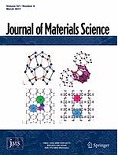From a novel synthesis method for bismuth tri-iodide nanoparticles to a solution-processed hybrid material : BiI3-conducting polymer
Dublin Core
Título
From a novel synthesis method for bismuth tri-iodide nanoparticles to a solution-processed hybrid material : BiI3-conducting polymer
Tema
NANOTECNOLOGIA
NANOPARTICULAS
POLIMEROS
TRIYODURO DE BISMUTO
BIBLIOGRAFIA NACIONAL QUIMICA
2022
Abstract
We successfully synthesized two types of bismuth tri-iodide nanoparticles: uncapped (BiI3) and capped with aniline (BiI3_ani), in order to study their potential as inorganic semiconductor for an organic–inorganic hybrid material with poly(3-hexylthiophene-2,5-diyl) (P3HT). We developed a novel direct synthesis method that avoids ligand exchange (for BiI3_ani), as well as the necessity of capping agent removal steps (for BiI3) and the formation of sec ondary compounds obtained by other techniques. Additionally, we evaluated and compared the properties of solution-processed P3HT:nanoparticles layers with the film sequence ITO/PEDOT:PSS/P3HT:nanoparticles, where ITO is indium tin oxide and PEDOT:PSS is poly(3,4-ethylenedioxythiophene) poly styrene sulfonate. We analyzed the layers by UV–Vis spectroscopy, X-ray diffraction, focused ion beam scanning electron microscopy and photolumi nescence analysis. We proved that aniline restricts the growth of nanoparticles and improves the processability of the material compared to nanoparticles without capping agent. We demonstrated that both types of nanoparticles can be successfully suspended in a solvent in which P3HT is soluble, improve the UV–Vis absorption of P3HT and interact with this polymer leading to an improved crystalline ordering on the blends compared to pristine P3HT layers. We also demonstrated that BiI3 nanoparticles produce a nanoscopic mixture with P3HT and that it is possible to exploit the photoluminescence emission of P3HT:BiI3_ani layers. Our results show that both types of nanoparticles can be good candidates for use in solution-processed organic–inorganic hybrid material with P3HT, which could be employed for the fabrication of hybrid polymeric–inorganic solar cells with BiI3 nanoparticles as electron acceptor and P3HT as electron donor.
Autor
Bethencourt Ramos, Loengrid Karina
Pérez Barthaburu, María
Oreggioni, Daniela
Costa de Santana, Ricardo
Queiroz Maia, Lauro June
Fornaro, Laura
Fuente
Journal of Materials Science, v. 57, 2022. -- pp. 17592-17608
Editor
Springer
Fecha
2022
Derechos
Información sobre Derechos de Autor
(Por favor lea este aviso antes de abrir los documentos u objetos)
La legislación uruguaya protege el derecho de autor sobre toda creación literaria, científica o artística, tanto en lo que tiene que ver con sus derechos morales, como en lo referente a los derechos patrimoniales con sujeción a lo establecido por el derecho común y las siguientes leyes (LEY 9.739 DE 17 DE DICIEMBRE DE 1937 SOBRE PROPIEDAD LITERARIA Y ARTISTICA CON LAS MODIFICACIONES INTRODUCIDAS POR LA LEY DE DERECHO DE AUTOR Y DERECHOS CONEXOS No. 17.616 DE 10 DE ENERO DE 2003, LEY 17.805 DE 26 DE AGOSTO DE 2004, LEY 18.046 DE 24 DE OCTUBRE DE 2006 LEY 18.046 DE 24 DE OCTUBRE DE 2006)
ADVERTENCIA: La consulta de este documento queda condicionada a la aceptación de las siguientes condiciones de uso: Este documento es únicamente para usos privados enmarcados en actividades de investigación y docencia. No se autoriza su reproducción con fines de lucro. Esta reserva de derechos afecta tanto los datos del documento como a sus contenidos. En la utilización o cita de partes debe indicarse el nombre de la persona autora.Formato
PDF
Extent
17 p.
Idioma
Inglés
Tipo
Artículo
Identificador
10.1007/s10853-022-07703-w
Document Item Type Metadata
Original Format
PDF
- Fecha de agregación
- December 13, 2022
- Colección
- Bibliografía Nacional Química
- Tipo de Elemento
- Document
- Etiquetas
- Nanopartículas, Nanotecnología, Polímeros, Triyoduro de Bismuto
- Citación
- Bethencourt Ramos, Loengrid Karina, “From a novel synthesis method for bismuth tri-iodide nanoparticles to a solution-processed hybrid material : BiI3-conducting polymer,” RIQUIM - Repositorio Institucional de la Facultad de Química - UdelaR, accessed August 25, 2024, https://riquim.fq.edu.uy/items/show/6582.
- Archivos

